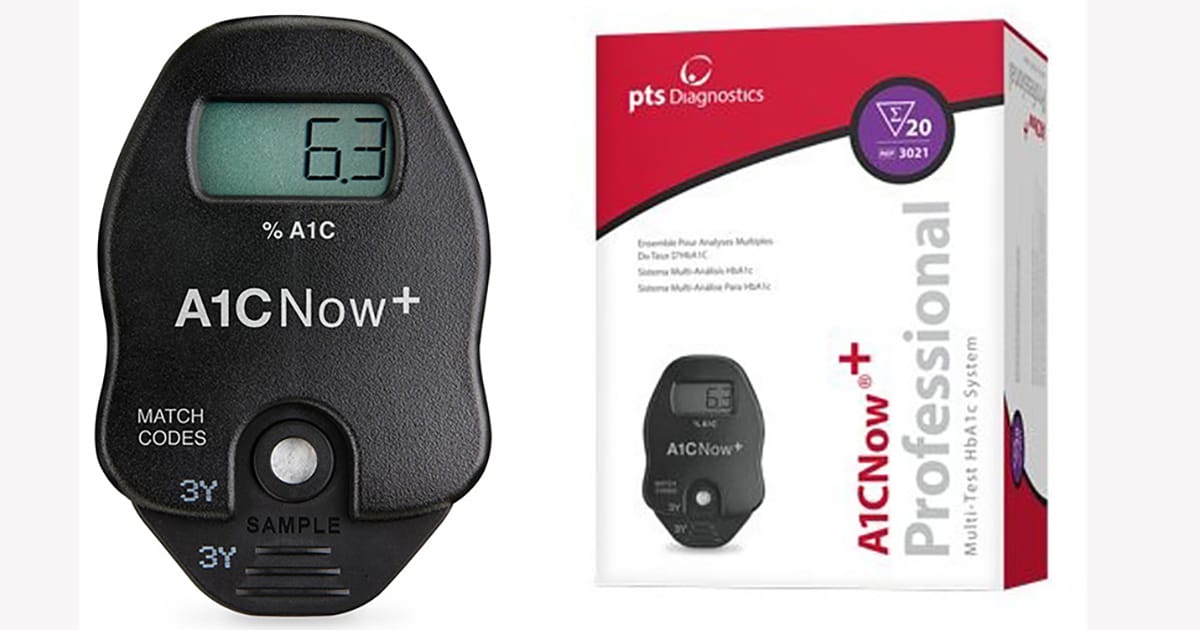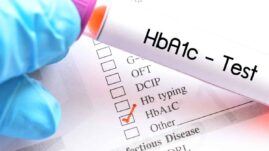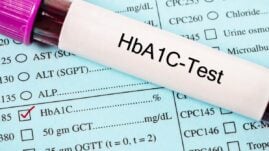This post may contain affiliate links. Please read our disclosure.
The A1c test, also known as glycated hemoglobin, hemoglobin A1c, or HbA1c, is essential for anyone living with diabetes.
While it doesn’t provide a complete picture of your diabetes management, it serves as an important indicator of whether your average blood glucose (sugar) levels are within a healthy range for you.
Today, I’ll guide you through the steps to measure your A1c easily and accurately at home.
We’ll also explore what the A1c test reveals, why it’s important, and how to understand the results.

Key facts
- The A1c test is a measure of average blood glucose control over the previous 2 to 3 months, with a recommended target generally below 7 percent for people living with diabetes.
- Routine monitoring of A1c levels helps manage diabetes effectively and avoid long-term complications.
- Home A1c test kits offer a convenient and accurate alternative to lab tests, delivering results within 5 minutes.
- While most health insurance plans cover lab-based A1c tests, coverage for at-home kits varies and should be verified with your insurance provider.
What is an A1c test?
The A1c test, a blood test, measures your average blood glucose levels over the past 2 to 3 months and is reported as a percentage. Typically, people without diabetes have an A1c below 5.7 percent.
This test serves as a valuable tool for diagnosing diabetes and evaluating the effectiveness of your diabetes management strategy.
The ADA provides the following guidelines for using the A1c test in diagnosing diabetes in nonpregnant:
| A1c Level | What It Means |
| Less than 5.7 percent | Normal |
| 5.7 percent to 6.4 percent | Prediabetes, meaning at increased risk for developing type 2 diabetes |
| 6.5 percent or greater | Diagnosed diabetes (with a second result for confirmation) |
The ADA recommends that many non-pregnant people with diabetes aim for an A1c of 7 percent or lower, which corresponds to an average blood sugar level of roughly 154 mg/dL (8.6 mmol/L).
Learn more in: How to Translate Your A1c to a Blood Sugar Level.
While some may target A1c levels closer to the normal range, it is crucial to avoid overly aggressive reductions that can lead to dangerous hypoglycemia (low blood sugar).
It’s important to personalize your A1c target in consultation with your healthcare provider, allowing adjustments as needed to suit your health needs and lifestyle.
Why is it important to measure your A1c
Monitoring your A1c is important as elevated blood sugars can lead to numerous short- and long-term diabetes complications. Keeping your A1c at a healthy level helps reduce these risks.
If your A1c levels begin to go above your target, you can take several steps to lower them, such as adjusting your medication with your healthcare provider’s guidance, altering your diet, increasing your physical activity, and making other lifestyle changes.
Read more in: How to Lower Your A1c: The Complete Guide.
Since the A1c test provides a snapshot of your average blood sugar levels over the last 2 to 3 months, it’s recommended to measure your A1c at least quarterly in people newly diagnosed and/or whose glucose levels are consistently above their target range.
This regular monitoring helps you track the effectiveness of your diabetes management strategies.
“I feel like I’m healthier now than I have been in decades. I’m exercising more and making more conscious diet choices.”
-Wes Moran (you can read how Wes lowered her A1c here)
For those who have steady glucose levels within their target, A1c testing may be recommended at least twice a year.
How to use the A1c home test kit
Measuring your A1c at home can be beneficial for several reasons, including limited access to see your healthcare provider, the distance to a lab, or the cost of lab work.
While there are several excellent options for home A1c testing at home, it is important to consult with your medical team before making any changes to your diabetes care or attempting to diagnose yourself.
One cost-effective option is the CVS A1C At Home Test Kit, which I demonstrate in the video below. This kit can deliver your A1c results on the spot in just 5 minutes.
A1c home test kit general instructions
Although exact instructions vary from kit to kit, general guidelines are as follows:
- Prepare your testing area by laying out all necessary equipment in a clean and dry area.
- Ensure your hands are clean for the procedure. You can wash them thoroughly with soap and water and dry them completely, or use an alcohol prep pad and wait for the alcohol to dry.
- Use the lancet on the side of your fingertip to minimize discomfort (avoid the fingertip pad as it may be more painful), and gently press to produce a small drop of blood.
- Position the blood collector against the blood drop, letting it absorb enough blood as specified by the manufacturer’s instructions.
- Attach the filled blood collector to the shaker device, secure it, and then shake vigorously for about 5 to 8 seconds to mix the sample with the solution.
- Open the test cartridge, insert it into the A1c analyzer, and use the base of the shaker to transfer the solution into the analyzer as directed. Once done, remove the base.
- Allow the device to process the results, which typically takes about 5 minutes. Avoid handling the analyzer during this time to ensure accuracy.
- Record your A1c result along with the date.
- Properly dispose of the used test cartridge and retain the analyzer for future use.
To ensure accuracy, follow the instructions included with your kit carefully and provide enough blood for the test, as insufficient samples may lead to errors.
Consider reading through the kit instructions prior to beginning the test to familiarize yourself with the steps. Also be sure to check the expiration date on your kit and store it according to the manufacturer’s instructions.
Are home A1c test kits accurate?
Home A1c test kits are generally considered to be as accurate as those performed in laboratories. Typically, these kits provide results with a precision of plus or minus 0.5 percentage points, which is about the same as most standard lab tests.
For guaranteed accuracy, it’s important to select kits that are NGSP-certified (National Glycohemoglobin Standardization Program), which ensures they meet rigorous testing standards similar to those used in professional laboratories.
Additionally, look for kits that have U.S. Food and Drug Administration (FDA) clearance or carry the Conformité Européenne (CE) mark.
FDA clearance indicates that the product has been assessed and deemed safe and effective for use in the United States, while the CE mark shows compliance with health and safety standards within the European Economic Area.
These certifications help ensure that the products meet rigorous health, safety, and environmental protection standards.
In my own experience using the A1CNow SelfCheck at home — demonstrated in the video above — the results matched perfectly with those from a lab test conducted at Quest Diagnostics just a few days prior. At least in my case, this confirms the reliability to me of certified home testing kits in real-world conditions.
How much does an A1c test kit cost?
The CVS A1C At Home Test Kit kit costs $52.79 on Amazon for a kit containing two tests as of December 2024. This was the most affordable option I found, though prices for similar home A1c kits on Amazon generally range from $60 to $100. (Prices for kits containing a single test can be as low as about $35.)
Home A1c kits are also available at major pharmacies like CVS and Walmart.
Additionally, there are kits that require you to collect a blood sample and send it to a lab. These kits necessitate collecting more blood (four to five large droplets) and may involve a wait time of up to 4 weeks for results, depending on mail speeds to and from the lab, as I have experienced.
Is it covered by insurance?
Most health insurance plans, including private and government plans, typically cover blood work prescribed by your doctor and conducted in a laboratory.
However, coverage for at-home A1c test kits is less certain unless the kit is specifically prescribed by a healthcare provider.
To determine if your plan covers these at-home kits, you should contact your insurance company or review your plan’s benefits. If covered, your insurer may recommend a preferred brand or specify a process for obtaining your kit.
Did you find this article helpful? Click Yes or No below to let us know!






Debbie Rom
Hi Christel,
Thankyou so much for all of your info.
I am on Metformin, twice daily, and I’d like to
know how and when is the best time to take it.
I take mine as soon as I get out of bed, then go
about making breakfast, then I do the finger stick
and check my blood. I write all of this in a book and
what I eat and drink. Then, I have my breakfast. Is
this right or wrong? Then I take my Metformin at 5pm
go about making dinner, then check my blood, and do
as I do in the morning. My numbers jump up and down
and I don’t know if I’m doing something wrong. Any
suggestions?
Christel Oerum
I think you’ll find this guide to Metformin helpful (https://diabetesstrong.com/everything-you-need-to-know-about-metformin/).
Generally, it’s recommended you take your Metformin with food and water to prevent gastric upset but if that’s not an issue for you you can probably continue to take it as you do. I don’t think when you take it has anything to do with your fluctuating blood sugars as long as you take it about the same time daily. Blood sugars will always fluctuate but if yours are generally elevated you might need to have your dose adjusted or start a different type of medication. A good idea is to bring your notebook to your next doctor’s appointment (I love that you’re keeping track) and show your doctor the fluctuations that you’re noticing. That will make it easier for your doctor to assess if your meds needs to be adjusted
Arshad Ahmed
are these FDA approved tests? if not, then how are these companies allowed to market these tests?
Christel Oerum
It is FDA cleared, you can read the specifications here: https://ptsdiagnostics.com/a1cnow-plus-system/
SantinA Caruso
Good morning Christel,
I happened upon you and your website this morning looking for suggested, at home, A1C test kits. Your information and insight is fantastic and I wonder if this information translates over to T2D’s. I am a recently diagnosed and refuse to take medicine and am trying to keep my BG levels within normal to pre-diabetic having done so for almost a year. As of late, my fasting BG is rising >125-140. I do not fit the T2D phenotype. I am thin, very active, and eat mostly a 1:1 protein to carb diet and am a pescetarian.
I want to learn how to eat, when to eat and what to eat and need to know if your information translates over to T2D or should I seek information and learning else where before reaching out my my local medical professionals.
Christel Oerum
Thank you, I’m glad you enjoy the content and find it helpful. Yes, everything in this article is relevant for people living with any type of diabetes.
As for specific, type 2 or pre-diabetes content, just use the navigation bar on the top of the page and you’ll find all of the categories. I do think this specific article would be good for you to read: https://diabetesstrong.com/is-type-2-diabetes-reversible/
Finally, please make sure that you have been tested for antibodies to ensure that you have the right diagnosis (https://diabetesstrong.com/lada-diabetes/). You can easily be lean and active and live with type 2, but as you mention we don’t see that that often
Keith
I don’t understand how A1C can be an average of anything if you are just imputing today’s blood. I know I sound retarded.
Christel Oerum
A blood draw today can reveal a lot about what has been going on in your body. An A1C test measures the percentage of red blood cells that have “sugar-coated” hemoglobin (a protein in your red blood cells). In the body, red blood cells are constantly forming and dying, but typically they live for about three months. Thus, the A1c test reflects the average of a person’s blood glucose levels over the past three months.
Cathy
I found out in April of this yr. I’m a diabetic, so my Dr. put me on the Metformin, horrible medicine, I had really bad side effects so I just started the insulin because he said it has less side effects. I have got my family telling me to see a specialist for my sugar, my Dr. is just a MD. What do you think?
Christel Oerum
Some MDs are excellent so there’s not a one size fits all answer. If you choose to see an endocrinologist make sure that the one you choose regularly sees people with type 2 diabetes. It’s can’t hurt to see a specialist, except they’re usually more expensive, for a second opinion
Susan
Insulin makes you gain weight even if you are super careful with what you eat all day every day. I would try to put up with the Metformin side effects for about a month if I could avoid the insulin by taking Met. I am a Type 2 diabetic. I am struggling hard to lose the weight insulin caused me to gain even though I fought the weight gain every step of the way. And I am still fighting.
Christel Oerum
It’s not quite true that everyone who takes insulin gains weight. There are plenty of people living with insulin-dependent diabetes that do not have weight issues and even some who struggle to keep on weight.
That doesn’t take away from your experience but I think we have to be very careful with blanket statements like that as they can scare some people away from a medication that can save their life.
You can read more about insulin and weight gain here https://diabetesstrong.com/insulin-weight-gain-does-tighter-control-make-you-loosen-your-belt/
Shaunti
The HgA1c now self check, after 4 test, can you get more test or is the kit disposed?
Christel Oerum
I haven’t seen any brands that sell the cartridges by themselves, so you’d have to order a new kit if you want more than 4 tests
Jacqui
So does the .5 difference mean a 7.0 lab test could read 6.5-7.5?
Christel Oerum
Yes, that is what it means
Erica
Where are the resources showing that the at-home ones are within plus/minus 0.5 percentage points? Thanks!
Christel Oerum
Here is the clinical data on the A1CNow SelfCheck specifically: https://ptsdiagnostics.com/a1cnow-accuracy/
Pam Koretsky
Is there going to be anything on GMI vs A1C for control and risk indicators? Lots of us are on CGMs now and have access to GMI numbers between blood work.
Christel Oerum
That’s not included in this article, but could be talked about in future pieces
Kevin
I find the reports from my Dexcom to be much more helpful than an A1c. More detail let’s me make more accurate adjustments and Time in Range seems a much better overall number to look at
Rebecca
With Pandemic I really don’t want to go in to a lab or dr office every 3 mos so was thinking of doing the A1c test at home and waiting another few mos (after vaccine since Ivan high risk). I went 3 mos ago and did not like the experience. Lab did not have precautions!! Why do we need to be checked every 3 mos instead of say 6? Time flies by! Type2 7 years
Christel Oerum
Then maybe this home test is for you. I agree, going to a lab right now is not the best experience.
The 3-months is to keep an eye on our numbers, so your doctor can react and suggest treatment changes if needed.
Aline
Hello,
Great info thank you.
I could not find the video on how to use the a1c kit.
Thank you.
Christel Oerum
Oh no, a few things could be going on. Some browsers won’t show it ? Another reason could be an ad blocker, if that’s the case you’d have to disable that. If none of that works, hang tight, I’m in the process of creating a more comprehensive A1C comparison for YouTube and this product is included
Christel Oerum
Hi Aline – the video is now part of this YouTube guide: https://youtu.be/5UYYB1L90pY